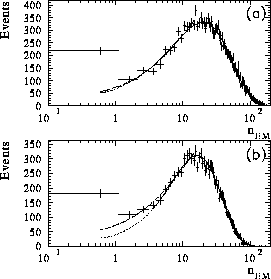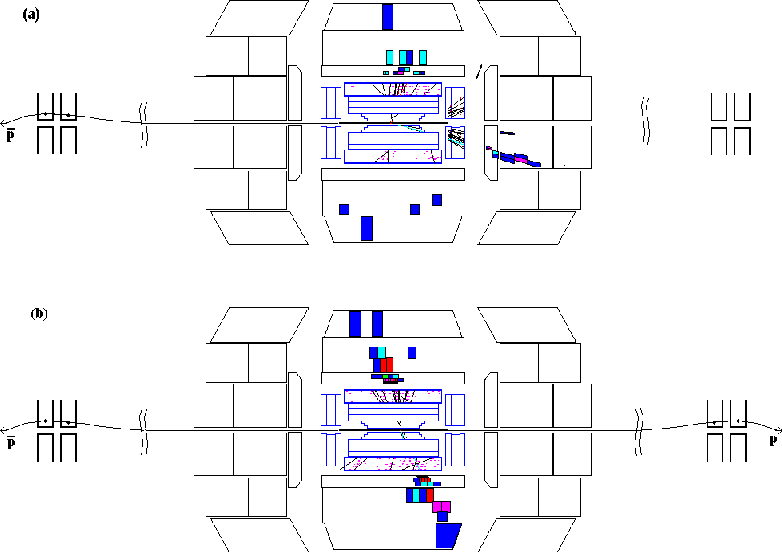The study of hard diffractive processes has expanded dramatically in recent years. Results from HERA and the Tevatron include the observation of diffractive jet production [10, 11, 12], diffractive W boson production [13], and rapidity gaps between high transverse energy jets [14, 15, 16, 17].
As an example of some of this work, we describe in detail a
DØ search for hard diffractive jet production
using rapidity gap techniques.
Preliminary results show evidence for hard diffractive jet production
at center-of-mass energies ![]() GeV and
630GeV [11].
The data used in this study were obtained using
a forward jet trigger requiring at least two jets above 12GeV in
the region
GeV and
630GeV [11].
The data used in this study were obtained using
a forward jet trigger requiring at least two jets above 12GeV in
the region ![]() or
or ![]() . A forward jet trigger
is ideal for studying diffractive jet production, since
the interacting parton in the pomeron
typically has a smaller momentum fraction than the one from the proton,
resulting in a boosted jet system.
Events with multiple
. A forward jet trigger
is ideal for studying diffractive jet production, since
the interacting parton in the pomeron
typically has a smaller momentum fraction than the one from the proton,
resulting in a boosted jet system.
Events with multiple ![]() interactions or spurious
jets have been removed. Jets are reconstructed using
a cone algorithm with radius
interactions or spurious
jets have been removed. Jets are reconstructed using
a cone algorithm with radius ![]() .
The number of EM towers (
.
The number of EM towers (![]() ) above a 200MeV energy threshold
is measured opposite the leading two jets (
) above a 200MeV energy threshold
is measured opposite the leading two jets (![]() GeV) in the region
GeV) in the region
![]() for the data. The (
for the data. The (![]() ) distribution
is shown in Fig. 3
for
) distribution
is shown in Fig. 3
for ![]() of (a) 1800GeV and (b) 630GeV.
The distributions at both center-of-mass energies
show a striking peak at zero multiplicity indicating a class of events with
no particles detected opposite the dijet system.
The curves shown are negative binomial fits to the data excluding low
multiplicity bins and extrapolated to zero to estimate the background from
standard color exchange, which is typically well described by such a
distribution [18]. The dashed curve is a fit to the whole
distribution, while the dotted curve is a fit to the leading edge only.
The excess at zero multiplicity for both
center-of-mass energies is on the order of 1% and is
in qualitative agreement with expectations for a hard diffractive component.
of (a) 1800GeV and (b) 630GeV.
The distributions at both center-of-mass energies
show a striking peak at zero multiplicity indicating a class of events with
no particles detected opposite the dijet system.
The curves shown are negative binomial fits to the data excluding low
multiplicity bins and extrapolated to zero to estimate the background from
standard color exchange, which is typically well described by such a
distribution [18]. The dashed curve is a fit to the whole
distribution, while the dotted curve is a fit to the leading edge only.
The excess at zero multiplicity for both
center-of-mass energies is on the order of 1% and is
in qualitative agreement with expectations for a hard diffractive component.
Figure 4(a) shows an actual DØ hard diffractive candidate
event with Roman pots superimposed. This overlay demonstrates
how a ``typical''
Run II event display might appear: a central jet, a forward jet,
calorimeter energy and charged tracks in one hemisphere, and a rapidity gap
and detected anti-proton in the other hemisphere.
Figure 4(b) shows a similar overlay with a
hard double pomeron exchange candidate
(extracted from a promising preliminary search for this class of
events described in Ref. [11] and Sec. 2.2.4),
which has two central jets and forward-backward rapidity gaps.
Both ![]() and p tracks could be detected in this
event with the Forward Proton Detector, the
details of which will be discussed later in this document.
and p tracks could be detected in this
event with the Forward Proton Detector, the
details of which will be discussed later in this document.

Figure 3: Number of electromagnetic calorimeter
towers (![]() ) above a 200MeV energy threshold for the region
) above a 200MeV energy threshold for the region
![]() opposite the forward jets for center-of-mass energies
of (a) 1800GeV and (b) 630GeV.
The curves are negative binomial fits to the data
excluding low multiplicity bins.
opposite the forward jets for center-of-mass energies
of (a) 1800GeV and (b) 630GeV.
The curves are negative binomial fits to the data
excluding low multiplicity bins.

Figure 4: Event displays showing Run I candidate events with
a Forward Proton Detector (not to scale) added.
(a) shows a hard diffractive candidate with a forward and central jet
and a large rapidity gap in the out-going ![]() hemisphere.
The
hemisphere.
The ![]() could be tagged by the FPD. (b) shows a hard
double pomeron candidate event with central jets and two rapidity
gaps. Both the p and
could be tagged by the FPD. (b) shows a hard
double pomeron candidate event with central jets and two rapidity
gaps. Both the p and ![]() could be tagged with the FPD.
could be tagged with the FPD.
The H1 and ZEUS Collaborations have published many papers on diffraction, and the combination of diffractive jet production with diffractive deep inelastic scattering measurements has led to a picture of the pomeron that is dominantly composed of hard gluons, but with some quark component [19]. Results from CDF on hard diffractive jet production (similar to the DØ analysis detailed above), combined with their observation of diffractive W boson production, also support a dominantly gluonic Pomeron, but do not yield much insight into the pomeron structure function. There are also questions about how to combine results from HERA and the Tevatron, as the normalization may depend on center-of-mass energy [20]. The normalization uncertainty arises from how the flux of pomerons in the proton is defined and whether or not the pomeron obeys the momentum sum rule, which states that the sum of the momentum fractions of the constituents of a particle should be one. The momentum sum rule is not obviously true for the pomeron, which may not be a traditional particle with a uniquely defined structure function. The data obtained with the FPD should shed light on many of these issues and lead to a coherent picture of the pomeron.